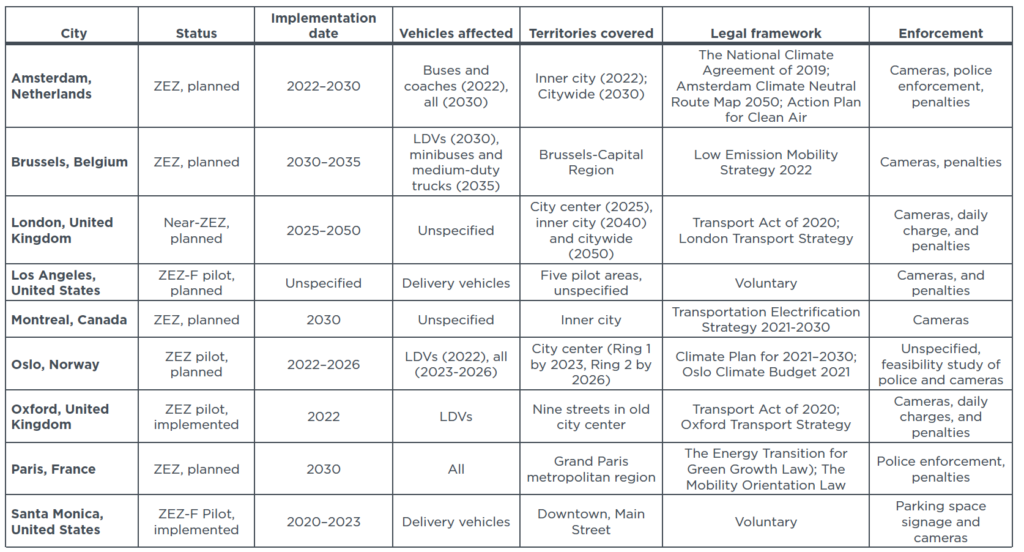ICCT published a paper to aid cities in planning and implementing low- and zero-emission zones by sharing lessons learned from Europe and North America. The study identifies underlying legal frameworks and enforcement mechanisms, reviews incentives to encourage the transition to zero-emission vehicles and other modes of mobility, and summarizes critical actions for cities to consider when planning low- and zero-emission zones.
The study finds that legal frameworks at the national level can allow cities to establish enforceable low- and zero-emission zones. However, without a national framework, cities can develop such zones using local and regional laws and voluntary pilot projects. Careful design and implementation of these zones can improve equity. Exemptions and financial incentives targeting impacted communities and small businesses could enable an equitable transition. Pilot projects with an equity focus can raise public awareness and support before fully implementing a low- or zero-emission zone.

Public communication and consultation are critical in every stage of planning and implementation of low- and zero-emission zones. To ensure public support and address concerns, cities have worked with experts, local organizations, and businesses to raise awareness about their benefits. Measuring and publishing data on pollution from internal combustion engine vehicles can illustrate the potential health benefits of zero-emission zones.
It’s an interesting and valuable report. However, it is not comprehensive. The recent ‘Verkeersbesluiten’ in Dutch cities Amsterdam, Rotterdam, and Maastricht show flaws in the planning process.
The level playing field is changed
The ‘Verkeersbesluit’ of Amsterdam states: “In the opinion of the Amsterdam College, the possible adverse consequences that individuals or companies experience from the traffic decree do not outweigh the interest served by this traffic decree, namely improving the air quality in Amsterdam and thereby preventing harmful effects on health on the one hand, and reducing CO2 emissions and thereby eventually reducing the effects on the climate on the other hand”. Rotterdam did calculate the societal benefits and concluded it’s a ‘no regret’ measure.
The financial impact on businesses and the adverse effects individuals or companies suffer from traffic decisions are particularly great for small business owners. This is also evident from the Dutch studies on charging infrastructure for logistics. The three Dutch cities did not analyze the impact on individual companies or city logistics segments.
ICCT states that carefully designing and implementing the zones can improve equity. But, this will not improve the structural impact on the level playing field for small business owners. The measures disrupt a previously level playing field based on diesel. How do the cities intend to ensure that even the small entrepreneurs in the region can continue to participate? And are these measures allowed by European competition rules?
The potential health benefits of zero-emission zones are not clear
There is no quantification of the health impact (specifically: what is the number of days of health gain?) on the one hand and the reduction of CO2 emissions on the other. Earlier, the GGD warned against optimism about the impact of zero-emission zones on air quality. According to TNO, the decreases in NOx, PM2.5, and PW10 would hardly be measurable (also, Rotterdam and TNO research came to this conclusion). Especially the particulate matter caused by tires, brakes, and asphalt wear is to blame. The GGD, therefore, pleaded earlier for less traffic, rather than cleaner traffic. In their draft ‘Verkeersbesluit’, the city of Rotterdam comprehensively analyzed the impact on air quality. This is an interesting document for other cities. Amsterdam did not calculate the impact on air pollution at all, because of a lack of reliable data on air pollution.
The devil is in the detail
Some issues are still unanswered, like:
- There will be two more evaluation moments in the Netherlands in 2024 before a final decision is taken on the next steps (according to the Dutch national implementation agenda) based on the future availability of electric vehicles, charging infrastructure, and net congestion. What do the open review in 2024 and other outstanding issues potentially mean for the traffic decision?
- The position of cold chain trucks has not yet been determined, and enforcement (and fines) on foreign trucks may not yet be in place.
- How do cities view cleaner HVO or BioLNG as fuel for city logistics? These alternative fuels can also achieve the desired CO2 gains.
- The cities have not yet adopted the implementation agenda for urban logistics. This should provide supporting policies for companies that can facilitate zero-emission driving. As an entrepreneur, you want to know where you stand in the future (also with the possible car-free plans). When is this implementation agenda coming?
- How will cities monitor the results measures after 2025?
- Classifying heavier electric vans on national and EU levels is a new issue for companies. The classification (N1) impacts driver’s license and access.
Cities should stimulate and facilitate more public and private dialogues to implement zero-emission city logistics solutions, enable scaling up innovative solutions (and join experiments), and create new business models to bring social, economic, and environmental benefits to all.
Walther Ploos van Amstel.
